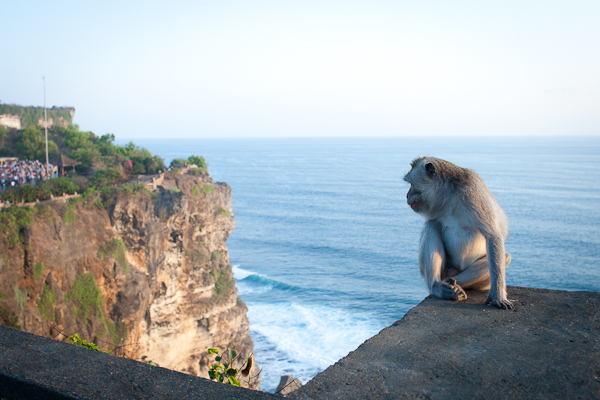Cape Ulu Watu is a popular destination for religious and tourist pilgrimages, and a popular world-class surf spot is also nearby. In the evenings, on the cape for tourists, they show the traditional Kechak dance, on a specially equipped open-air area. Ulu Watu is also widely known for its indigenous population - a large family of arrogant monkeys :) I heard a lot about the impudence and agility of these animals, but the first meeting, nevertheless, was a complete surprise to me.
We arrived at the cape in the evening, a little earlier than sunset, the traditional time of arrival for large tourist groups, in order to avoid crowds. At the entrance to the complex, along with tickets and sarongs, we were offered to buy bananas for the monkeys, we agreed ... Sarong is a traditional dress, it is a large piece of painted fabric that is worn like a skirt. Men must wear a sarong when entering a Balinese temple, women - if their knees are visible. I thought to myself that I need to hold the camera more tightly when I feed the monkey. But as soon as I crossed the gates of the temple, I no longer needed these precautions. The bananas were taken out of my cold hands so quickly that I didn't even have time to figure it out. I am sure that if the monkeys were interested in my camera, then I would not have time to blink an eye, as he would have appeared in them. Two rather large monkeys in a split second scrambled _on me_, clinging to the dress with dexterous hands, grabbed the bananas and calmly went to eat :) After that, it would seem, you can safely walk, since there was no food left for the shaggy ones, but it was not there !
For example, this fellow posed for a long time and effectively to the delight of tourists, and when he got tired, he went downstairs and, briskly assessing the situation, began actively trying to steal my flip flops! At that moment, I realized that choosing my shoes was a big mistake. In the power, I'm not afraid of this word, confrontation for the Vietnamese women, I eventually won, pressing my leg strongly to the ground. :) Having tugged his slippers a couple of times, the monkey went in search of another prey. After that, we already armed ourselves with long sticks, following the example of the guides, to scare away impudent primates. And the motives of theft are quite practical - the stolen goods are redeemed for another banana. In serious cases, for denyuzhka local workers who skillfully exchange things from monkeys.
There is a walking path along the cape, which offers simply breathtaking views of the cape and the turquoise ocean. In some places there is no fence, you can effectively jump if you want to :) Walking along the cape, associations with the temple of monkeys from "Mowgli", lost among the jungle, are involuntarily born. The place is incredible in beauty and power, but somewhat overcrowded with tourists.






